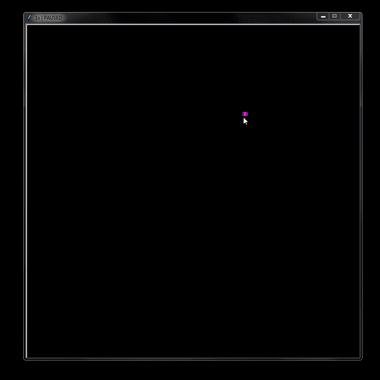Here's ~2 hours of mucking around making the game of life in python with tkinter. Not much to do.
Press enter to pause/continue.
Square brackets to change delay between updates (limited between 0.0125s and 1.6s).
Backspace to clear.
You can only toggle populations and change speed when paused.
Probably not the best written thing in the world, but I don't care. This was just for the fun of it. Looking at cellular automata. In fact I'm pretty sure it's got a couple bugs. Just got to the point at which I can click buttons and it works for a bit and started playing with it, lol.
My main gripe would be the fact that labels are pretty slow to create and update. Would probably be much better to use a widget with direct pixel access instead and just use the coordinates of clicks on the window to figure out what to populate/depopulate.
import tkinter
import time
import threading
class gameOfLife:
def __init__(self, width, height):
self.width = width
self.height = height
self.makeGrid()
self.paused = True
self.delay = 0.2
self.gui = GoLGUI(self)
def clock(self):
while True:
if not self.paused:
self.tick()
time.sleep(self.delay)
def toggletick(self):
self.paused = not self.paused
if self.paused:
self.gui.window.wm_title("PAUSED x"+str(self.delay))
else:
self.gui.window.wm_title("x"+str(self.delay))
def changeSpeed(self, multiplicand):
if self.paused:
if (self.delay * multiplicand) > 0.01 and (self.delay * multiplicand) < 2:
self.delay *= multiplicand
if self.paused:
self.gui.window.wm_title("PAUSED x"+str(self.delay))
else:
self.gui.window.wm_title("x"+str(self.delay))
def reset(self):
if self.paused:
self.makeGrid()
for x in range(self.width):
for y in range(self.height):
self.gui.buttonsDict["{0}.{1}".format(x, y)].configure(bg="#FF00FF")
self.gui.window.update()
for x in range(self.width):
for y in range(self.height):
self.gui.buttonsDict["{0}.{1}".format(x, y)].configure(bg="#000000")
self.gui.window.update()
def makeGrid(self):
self.grid = {x:{y:False for y in range(self.height)} for x in range(self.width)}
def changeState(self, x, y):
if self.paused:
self.grid[x][y] = not self.grid[x][y]
if self.grid[x][y]:
self.gui.buttonsDict["{0}.{1}".format(x, y)].configure(bg="#FFFFFF")
else:
self.gui.buttonsDict["{0}.{1}".format(x, y)].configure(bg="#000000")
def tick(self):
nextGrid = {x:{y:False for y in range(self.height)} for x in range(self.width)}
for x in range(self.width):
for y in range(self.height):
if self.grid.get(x).get(y):
nextGrid[x][y] = sum([sum([self.grid.get(xi, {}).get(yi, False) for yi in range(y-1, y+2)]) for xi in range(x-1,x+2)])-1 in [2, 3]
if nextGrid[x][y] != self.grid[x][y]:
self.gui.buttonsDict["{0}.{1}".format(x, y)].configure(bg="#000000")
else:
nextGrid[x][y] = sum([sum([self.grid.get(xi, {}).get(yi, False) for yi in range(y-1, y+2)]) for xi in range(x-1,x+2)]) == 3
if nextGrid[x][y] != self.grid[x][y]:
self.gui.buttonsDict["{0}.{1}".format(x, y)].configure(bg="#FFFFFF")
self.gui.window.update()
self.grid = nextGrid
class GoLGUI:
def __init__(self, game):
self.game = game
self.window = tkinter.Tk()
self.window.wm_title("PAUSED x"+str(self.game.delay))
self.window.resizable(False, False)
self.window.geometry("800x800")
self.buttonsDict = {}
for x in range(self.game.width):
self.window.grid_columnconfigure(x, weight=1)
for y in range(self.game.height):
self.window.grid_rowconfigure(y, weight=1)
buttonCmd = self.buttonCmdGen(x, y)
self.buttonsDict["{0}.{1}".format(x, y)] = tkinter.Label(self.window, bg="#000000")
self.buttonsDict["{0}.{1}".format(x, y)].grid(row=y, column=x, sticky="nesw")
self.buttonsDict["{0}.{1}".format(x, y)].bind("<Button-1>", buttonCmd)
self.window.bind("[", lambda a:self.game.changeSpeed(2))
self.window.bind("]", lambda a:self.game.changeSpeed(0.5))
self.window.bind("<Return>", lambda a:self.game.toggletick())
self.window.bind("<BackSpace>", lambda a:self.game.reset())
def buttonCmdGen(self, x, y):
return lambda a: self.game.changeState(x, y)
game = gameOfLife(50, 50)
loop = threading.Thread(target=game.clock)
loop.start()
game.gui.window.mainloop()If anything, it'd be fun to see the people from the #noobsofpython and #knightsofpython improve or rewrite this! @Miguel_Sensacion
